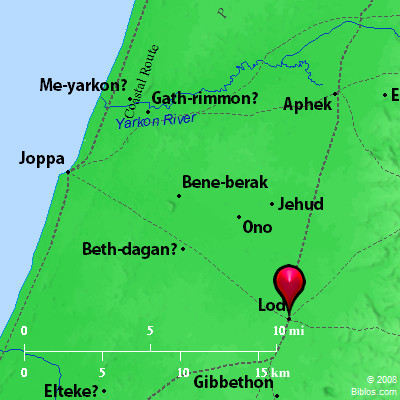Atlas  Lud (Lod) and surrounding area
Maps Created using Biblemapper 3.0Additional data from OpenBible.info
You are free to use up to 50 Biblos coprighted maps (small or large) for your website or presentation. Please credit Biblos.com. Occurrences Isaiah 66:19 "I will set a sign among them, and I will send such as escape of them to the nations, to Tarshish, Pul, and Lud, who draw the bow, to Tubal and Javan, to the islands afar off, who have not heard my fame, neither have seen my glory; and they shall declare my glory among the nations. Jeremiah 46:9 Go up, you horses; and rage, you chariots; and let the mighty men go forth: Cush and Put, who handle the shield; and the Ludim, who handle and bend the bow. Ezekiel 27:10 Persia and Lud and Put were in your army, your men of war: they hanged the shield and helmet in you; they set forth your comeliness. Ezekiel 30:5 Ethiopia, and Put, and Lud, and all the mixed people, and Cub, and the children of the land that is in league, shall fall with them by the sword. Encyclopedia LUD; LUDIMlud, lu'-dim, lood'-im (ludh, ludhim, ludhiyum, "Ludites"; Loud, Loudieim; Targum Onk: ludha'e):
1. Two Different Nationalities:
In Genesis 10:13 Ludim appears as the firstborn of Mizraim (Egypt), and in 10:22 Lud is the fourth son of Shem. We have therefore to do with two different nationalities bearing the same name, and not always easy to distinguish. 1 Chronicles 1:11, 17 simply repeat the statements of Genesis 10:13, 22. In Isaiah 66:19 Lud is mentioned with Tarshish and Pul (generally regarded as a mistake for Phut), Tubal, Javan, and the isles. Accepting this emendation, the passage agrees with Jeremiah 46:9, where the Ludim are spoken of with Kush and Phut as the allies of Egypt; and also with Ezekiel 27:10, where Lud is referred to with Persia and Put as soldiers of Tyre. Lud, again, is mentioned with Ethiopia (Gush), Put, all the mingled people, Cab, and the children of the land which is in league (or, margin "the land of the covenant"), which were all to fall by the sword (Ezekiel 30:5).
2. The Semitic Lud:
Coming to the Semitic Lud, it is to be noted that the Assyrians called Lydia Lu(d)du, and that the mythical ancestor of the Lydians, according to Herodotus (i.7), was Lydos, and their first king, Agros, was descended from Ninos and Belos, i.e. Assyria and Babylonia. The apparently Assyrian colony in Cappadocia about 2000 B.C., who used the Babylonian script, may be regarded as supporting this statement, and that there were other colonies of the same nationality in the neighborhood is implied by the fact that Assyro-Babylonian was one of the official languages of the Hittite state whose capital was Hattu or Boghaz-keui. On the other hand when Gyges sent an embassy to Assur-bani-apli of Assyria, Lu(d)du is described as a country whose name had never before been heard, and whose language was unknown. As, however, the earlier kings of Assyria certainly warred in that district, this statement has to be taken with caution. Perhaps the name had changed in the interval, owing to an immigration similar to that which brought the Hittites into Asia Minor, and caused change in the language at the same time.
3. Not Recognizable as Semitic Later:
Naturally Lydia was not recognizable as Semitic in classical times. The existence of Lud in the neighborhood of Egypt as well as in Asia Minor finds parallels in the Syrian Mucri of the Assyrian inscriptions by the side of the Mucur which stood for Egypt, and still more in the Cappadocian Cush (Kusu) of certain Assyrian letters relating to horses, by the side of the Cush (Kusu likewise) which stands for Ethiopia.
4. Egyptian Lud Not Recognizable:
Everything points, therefore, to the Semitic Lud and Ludim being Lydia, and the identification may be regarded as satisfactory. It is altogether otherwise with the Egyptian Lud and Ludim, however, about which little can be said at present. The reference to a city which seems to be Putu-yawan in an inscription mentioning the 37th year of Nebuchadrezzar, and apparently referring to an expedition against Amasis, though it may stand for "Grecian Phut," has very little bearing upon the position of the Egyptian Lud, especially as the text in which it occurs is very mutilated. One thing is certain, however: the Hebrews regarded this Lud and Ludim as being Hamitic, and not Semitic.
T. G. Pinches |




